CADILLAC DEVILLE 1998 7.G Service Manual
Manufacturer: CADILLAC, Model Year: 1998, Model line: DEVILLE, Model: CADILLAC DEVILLE 1998 7.GPages: 386, PDF Size: 22.36 MB
Page 41 of 386
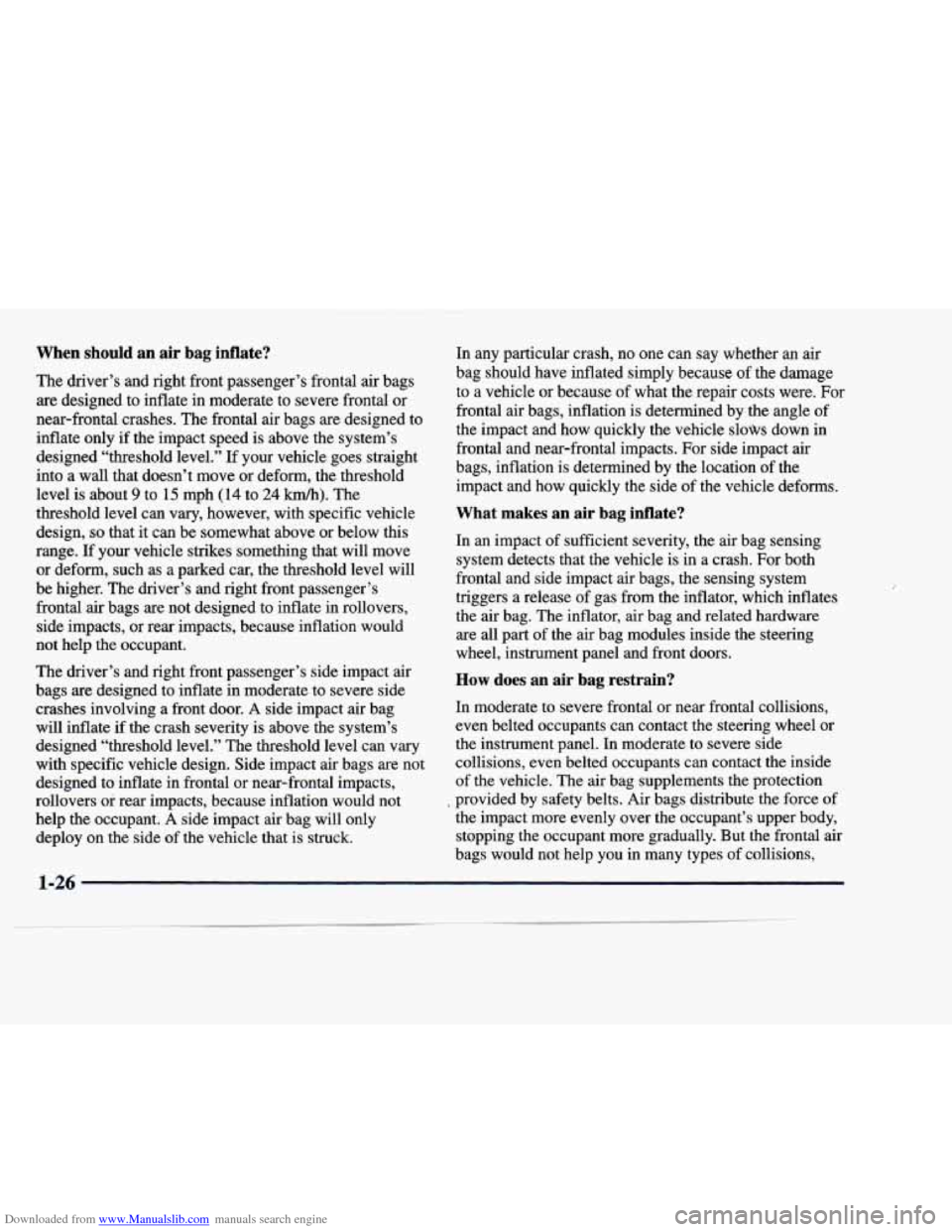
Downloaded from www.Manualslib.com manuals search engine When should an air bag inflate?
The driver’s and right front passenger’s frontal air bags
are designed to inflate in moderate to severe frontal or
near-frontal crashes. The frontal air bags are designed to
inflate only if the impact speed
is above the system’s
designed “threshold level.” If your vehicle goes straight
into a wall that doesn’t move or deform, the threshold
level is about 9 to 15 mph (14 to 24 km/h). The
threshold
level can vary, however, with specific vehicle
design,
so that it can be somewhat above or below this
range. If your vehicle strikes something that will move
or deform, such as a parked car, the threshold level will
be higher. The driver’s and right front passenger’s
frontal air bags are not designed to inflate in rollovers,
side impacts, or rear impacts, because inflation would
not help the occupant.
The driver’s and right front passenger’s side impact air
bags are designed to inflate in moderate to severe side
crashes involving a front door.
A side impact air bag
will inflate if the crash severity is above the system’s
designed “threshold level.” The threshold level can
vary
with specific vehicle design. Side impact air bags are not
designed to inflate in frontal or near-frontal impacts,
rollovers
or rear impacts, because inflation would not
help the occupant.
A side impact air bag will only
deploy on the side of the vehicle that is struck. In
any particular crash, no one can say whether
an air
bag should have inflated simply because of the damage
to a vehicle or because of what the repair costs were. For
frontal air bags, inflation is determined by. the angle of
the impact and how quickly the vehicle slo3vs down in
frontal and near-frontal impacts. For side impact air
bags, inflation is determined
by the location of the
impact and how quickly the side of the vehicle deforms.
What makes an air bag inflate?
In an impact of sufficient severity, the air bag sensing
system detects that the vehicle is in a crash. For both
frontal and side impact air bags, the sensing system
triggers a release of gas from the inflator, which’inflates
the air bag. The inflator, air bag and related hardware are all part
of the air bag modules inside the steering
wheel, instrument panel and front doors.
How does an air bag restrain?
In moderate to severe frontal or near frontal collisions,
even belted occupants can contact the steering wheel or
the instrument panel. In moderate to severe side
collisions, even belted occupants can contact the inside of the vehicle. The air bag supplements the protection
provided by safety belts. Air bags distribute the force of the impact more evenly over the occupant’s upper body, stopping the occupant more gradually.
But the frontal air
bags would not help you in many types of collisions,
Page 42 of 386
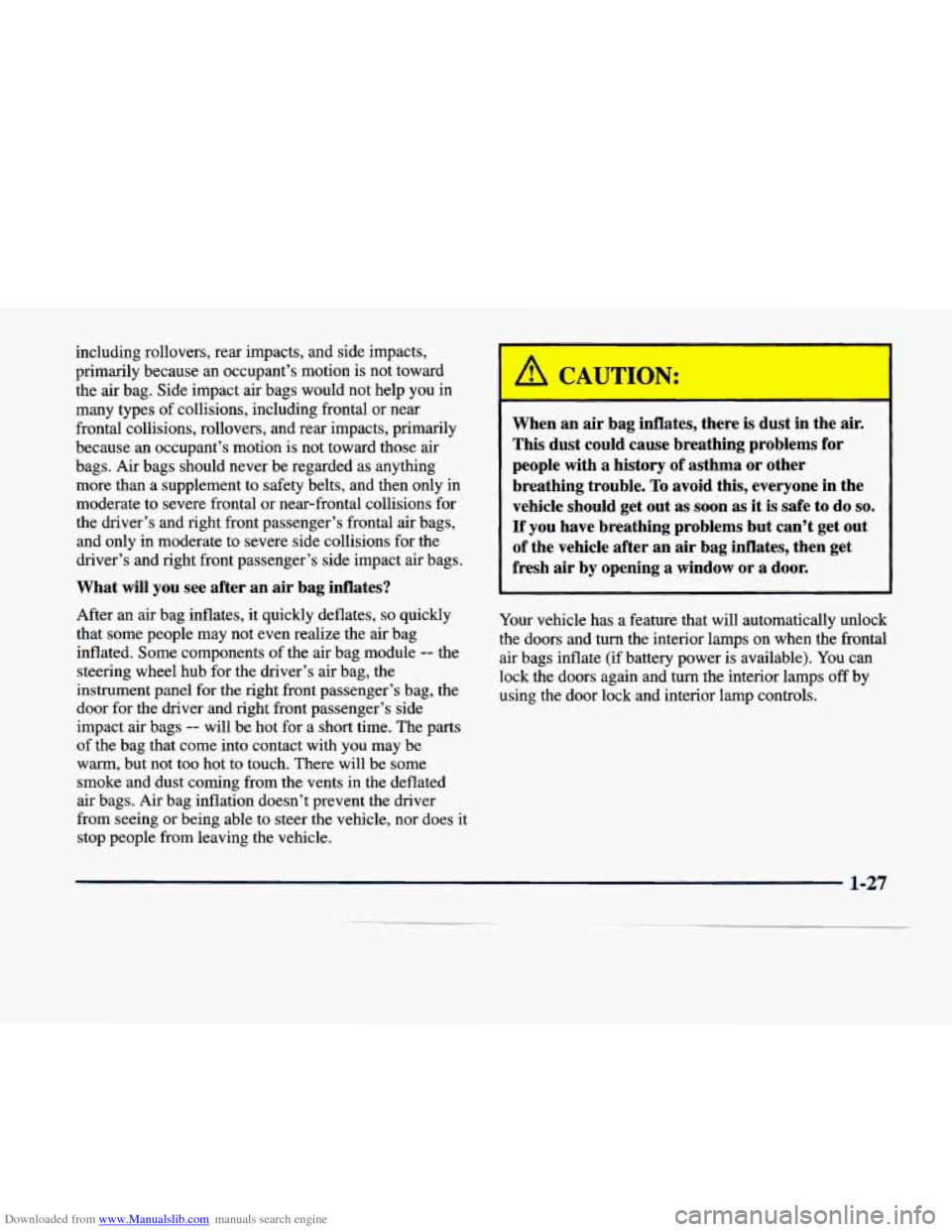
Downloaded from www.Manualslib.com manuals search engine including rollovers, rear impacts, and side impacts,
primarily because an occupant’s motion is not toward the air bag. Side impact air bags would not help you in
many types of collisions, including frontal or near
frontal collisions, rollovers, and rear impacts, primarily
because an occupant’s motion is not toward those air
bags. Air bags should never be regarded as anything
more than a supplement to safety belts, and then only in
moderate to severe frontal or near-frontal collisions for
the driver’s and right front passenger’s frontal air bags,
and only in moderate to severe side collisions for the
driver’s and right front passenger’s side impact air bags.
What will you see after an air bag inflates?
After an air bag inflates, it quickly deflates, so quickly
that some people may not even realize the air bag inflated. Some components of the air bag module
-- the
steering wheel hub for the driver’s air bag, the
instrument panel for the right front passenger’s bag, the
door for the driver and right front passenger’s side
impact air bags
-- will be hot for a short time. The parts
of the bag that come into contact with you may be
warm, but not too hot to touch. There will be some
smoke and dust coming from the vents in the deflated
air bags. Air bag inflation doesn’t prevent the driver
from seeing or being able to steer the vehicle, nor does it
stop people from leaving the vehicle.
When an air bag inflates, there is dust in the air.
This dust could cause breathing problems for
people with a history of asthma or other breathing trouble,
To avoid this, everyone in the
vehicle should get out as
soon as it is safe to do so.
If you have breathing problems but can’t get out
of the vehicle after an air bag inflates, then get
fresh air by opening a window or a door.
Your vehicle has a feature that will automatically unlock
the doors and turn the interior lamps on when the frontal
air bags inflate (if battery power is available). You can
lock the doors again and turn the interior lamps
off by
using the door lock and interior lamp controls.
1-27
Page 43 of 386
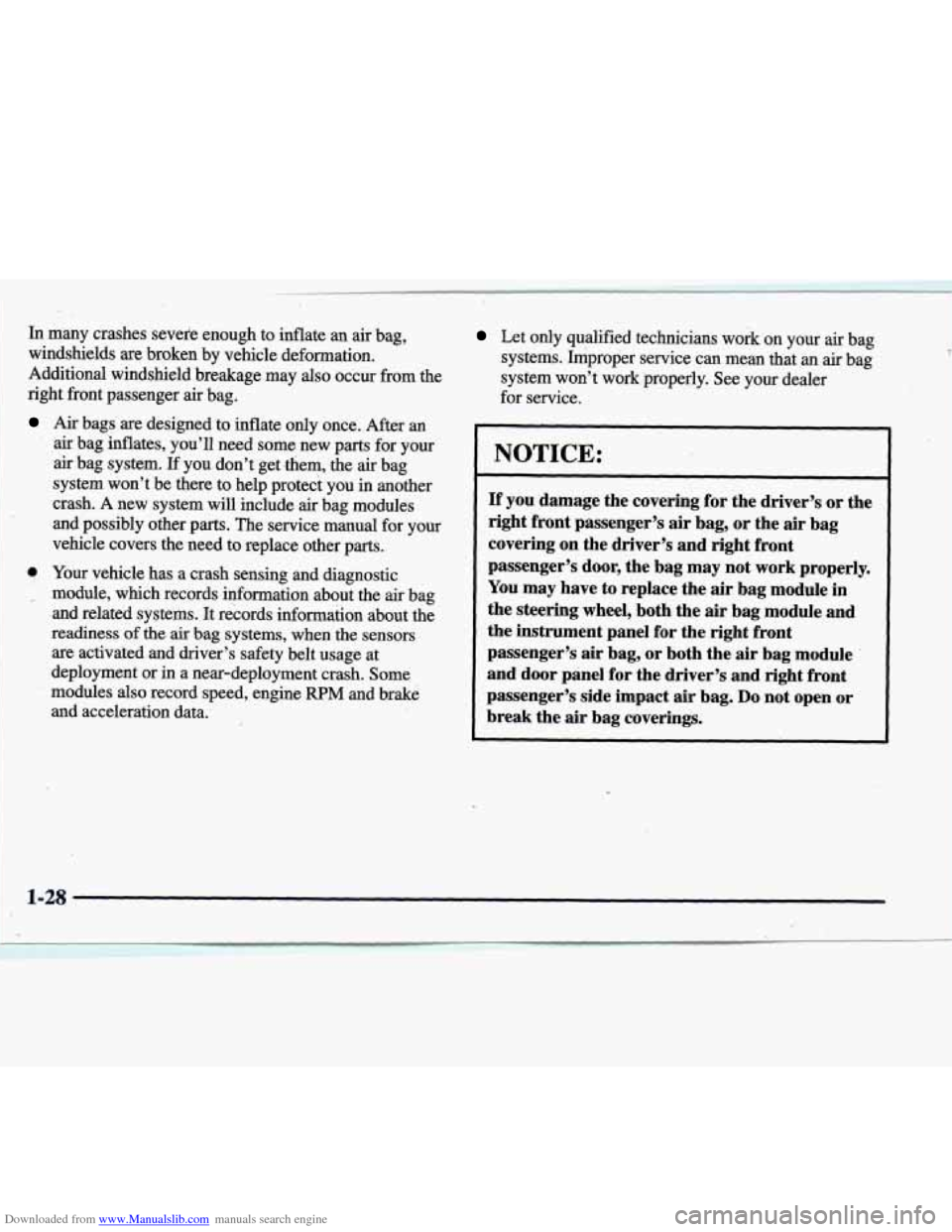
Downloaded from www.Manualslib.com manuals search engine 1
In many crashes sevefe enough to inflate ‘an air bag,
windshields are broken by vehicle deformation.
Additional windshield breakage may also occur
from the
right front passenger air bag.
Air bags are designed to inflate only once. After an
,air bag inflates, you’ll need some new parts for your
air bag system. If you don’t ‘get .them, -the air bag
system won’t be there to help pr0tec.t you
in another
crash.
A new system will include air bag modules
and possibly other
parts. The service manual for your
vehicle covers the need
to replace other parts.
@ Your vehicle has a crash sensing and diagnostic
__ module, which records information about the air bag
and related systems.
It records information about the
readiness
of the air bag systems, when the sensors
are activated and driver’s safety belt usage at
deployment or
in a near-deployment crash. Some
modules also record speed, engine
RPM and brake
and acceleration data.
Let only qualified technicians work on your air bag
systems. &proper service can mean that an
air bag
system won? work properly. See your dealer
for service.
NOTICE:
If you damage ,the covering for the driver’s or the
right front passenger’s
air bag, or the air bag
covering
on the driver’s and right front
passenger’s door, the bag may not work properly.
You may have to replace the air bag module
in
the steering wheel, both the air bag module and
the instrument panel for the right front
passenger’s air bag,
or both the air bag module ’
and door phel for the driver’s and right front
passenger’s side impact
air bag. Do not open or
break the
air bag coverings.
1-28 1 I
Page 44 of 386
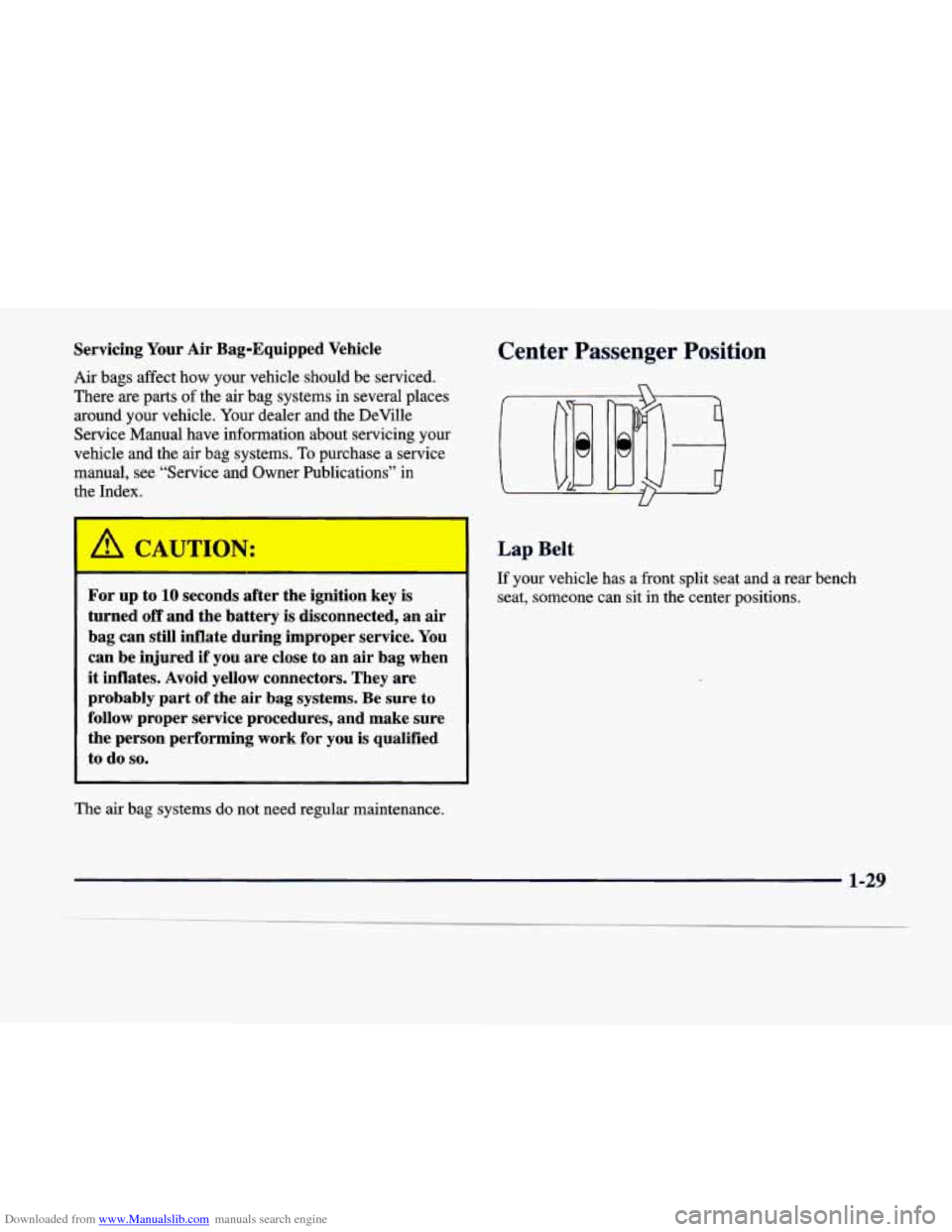
Downloaded from www.Manualslib.com manuals search engine Servicing Your Air Bag-Equipped Vehicle
Air bags affect how your vehicle should be serviced. There are
parts of the air bag systems in several places
around your vehicle. Your dealer and the DeVille
Service Manual have information about servicing your
vehicle and the air bag systems.
To purchase a service
manual, see “Service and Owner Publications” in
the Index.
/1 CAUTION:
I
For up to 10 seconds after the ignition key is
turned off and the battery is disconnected, an air
bag can still inflate during improper service. You
can be injured if you are close
to an air bag when
it inflates. Avoid yellow connectors. They are
probably part
of the air bag systems. Be sure to
follow proper service procedures, and make sure
the person performing work for you is qualified
to do
so.
The air bag systems do not need regular maintenance.
Center Passenger Position
Lap Belt
If your vehicle has a front split seat and a rear bench
seat, someone can sit in the center positions.
1-29
Page 45 of 386
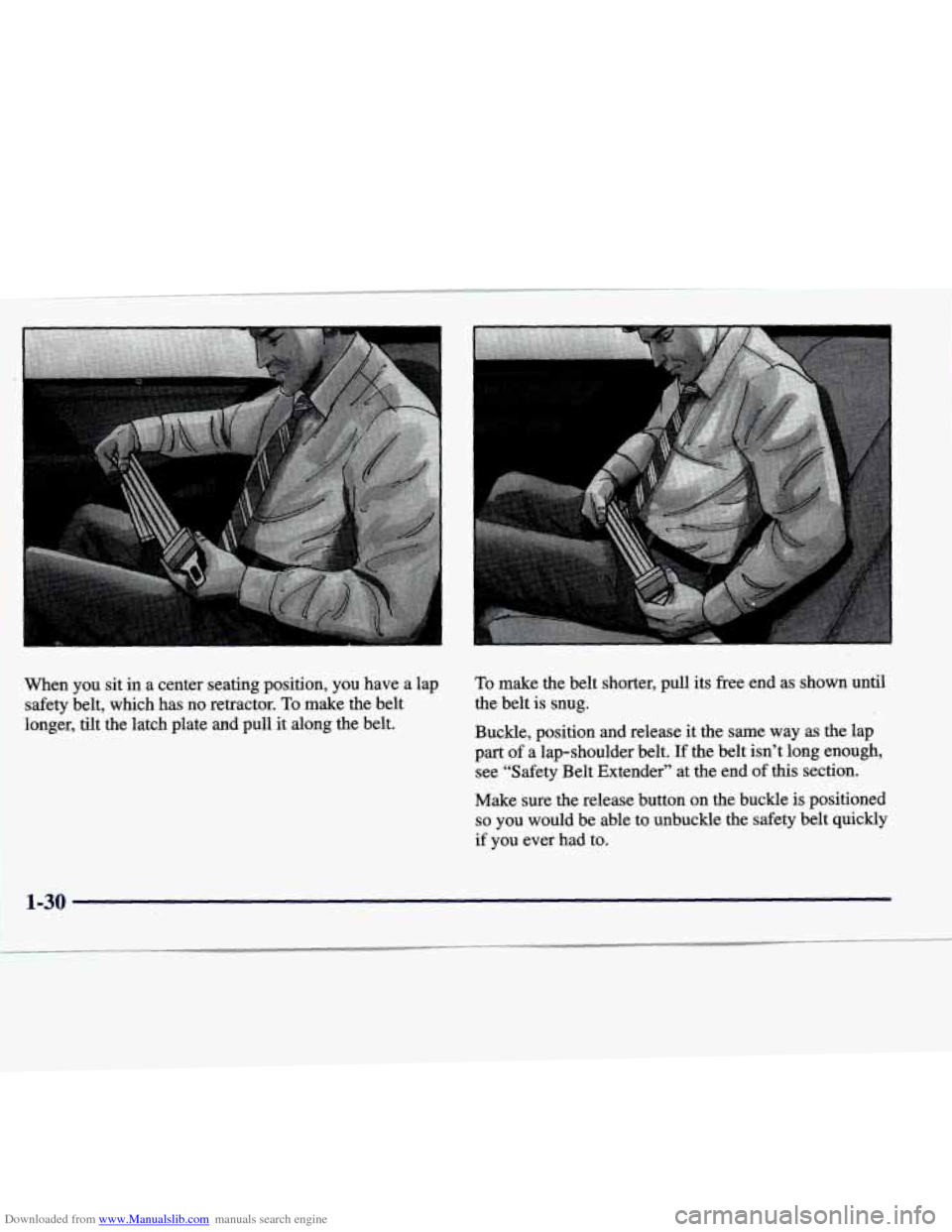
Downloaded from www.Manualslib.com manuals search engine When you sit in a center seating position, you have a lap
safety belt, which has no retractor.
To make the belt
longer, tilt the latch plate and pull
it along the belt.
To make the belt shorter, pull its free end as shown until
the belt is snug.
Buckle, position and release it the
same way as the lap
part of a lap-shoulder belt.
If the belt isn’t long enough,
see “Safety Belt Extender” at the end
of this section.
Make sure the release button on the buckle
is positioned
so you would be able to unbuckle the safety belt quickly
if you ever had to.
1-30
1 I
Page 46 of 386
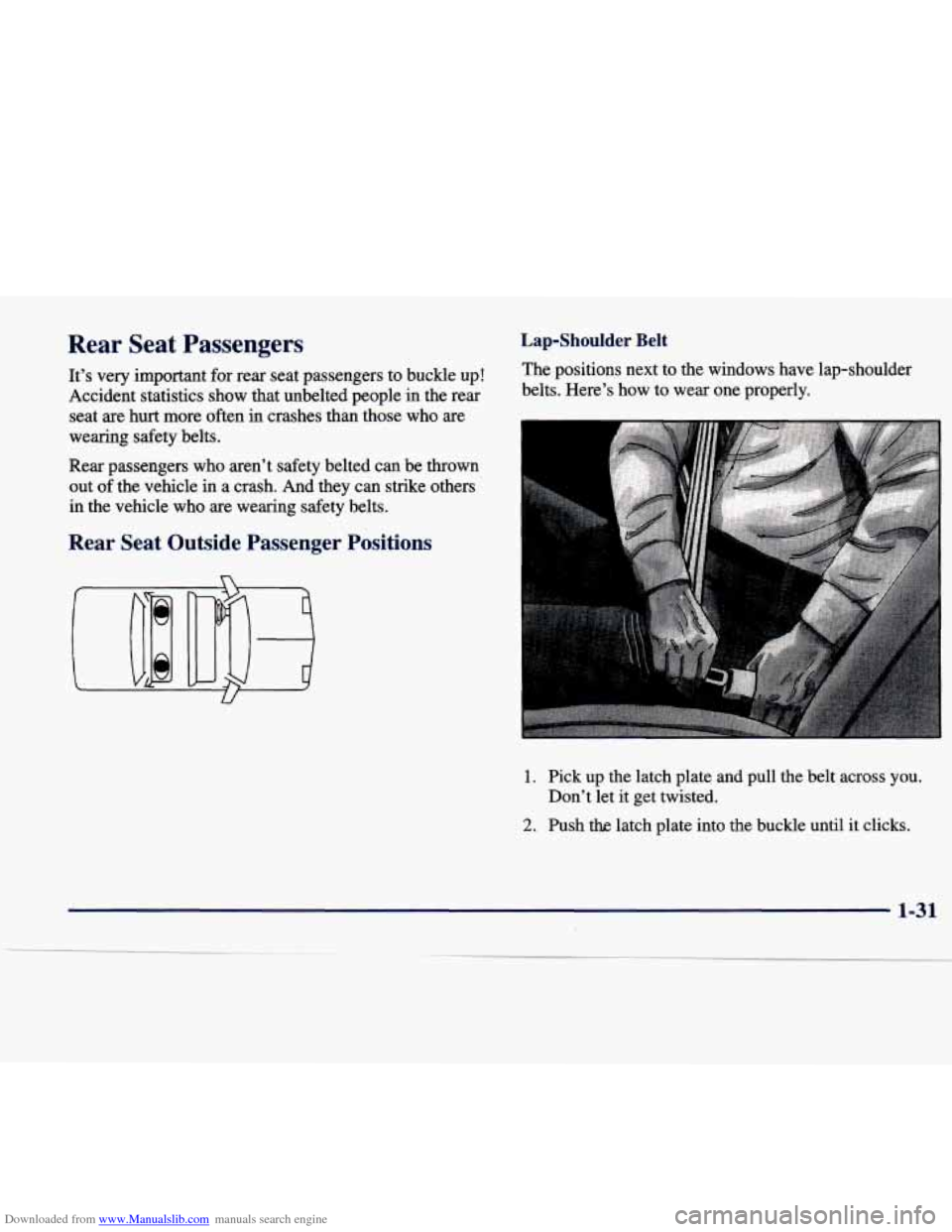
Downloaded from www.Manualslib.com manuals search engine Rear Seat Passengers
It’s very important for rear seat passengers to buckle up!
Accident statistics show that unbelted people in the rear
seat are hurt more often
in crashes than those who are
wearing safety belts.
Rear passengers who aren’t safety belted can be thrown
out
of the vehicle in a crash. And they can strike others
in the vehicle who are wearing safety belts.
Rear Seat Outside Passenger Positions
Lap-Shoulder Belt
The positions next to the windows have lap-shoulder
belts. Here’s how to wear one properly.
1. Pick up the latch plate and pull the belt across you.
2. Push thie latch plate into the buckle until it clicks.
Don’t let
it get twisted.
1-31
Page 47 of 386
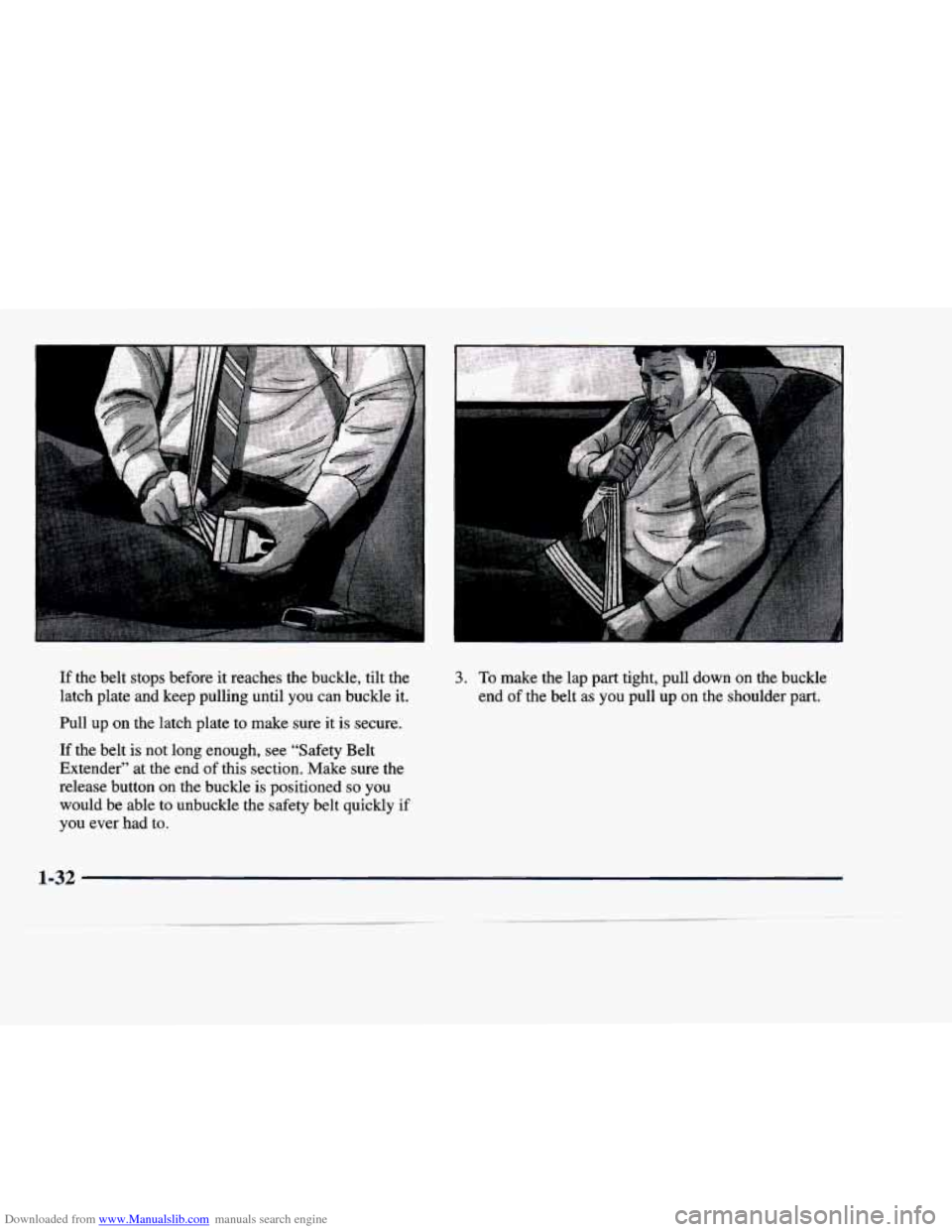
Downloaded from www.Manualslib.com manuals search engine If the belt stops before it reaches the buckle, tilt the
latch plate and keep pulling until you can buckle it.
Pull up on the latch plate to make sure it is secure.
If the belt is not long enough, see “Safety Belt
Extender” at the end of this section. Make sure the
release button on the buckle is positioned
so you
would be able to unbuckle the safety belt quickly if
you ever had to.
3. To make the lap part tight, pull down on the buckle
end
of the belt as you pull up on the shoulder part.
1-32
Page 48 of 386
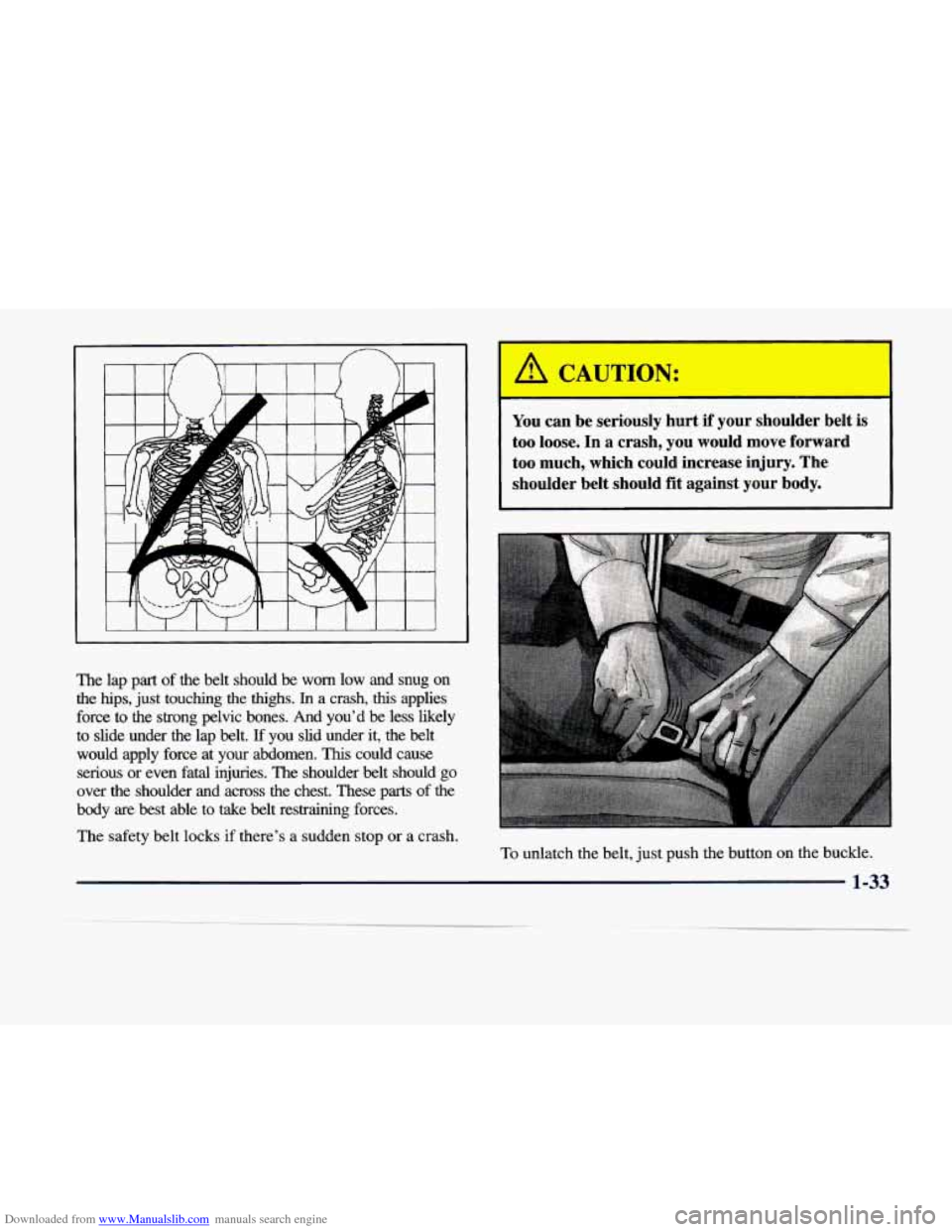
Downloaded from www.Manualslib.com manuals search engine The lap part of the belt should be worn low and snug on
the hips, just touching the thighs. In a crash, this applies
force to the strong pelvic bones. And you’d be less likely \
to slide under the lap belt.
If you slid under it, the belt
would apply force at your abdomen.
This could cause
serious or even fatal injuries. The shoulder belt should go
over the shoulder and across the chest. These parts of the
body are best able to take belt restraining forces.
The safety belt locks if there’s a sudden stop or a crash.
L
You can be seriously hurt if your shoulder belt is
too loose. In a crash, you would move forward
too much, which could increase injury. The
shoulder belt should fit against your body.
To unlatch the belt, just push the button on the buckle.
1-33
Page 49 of 386
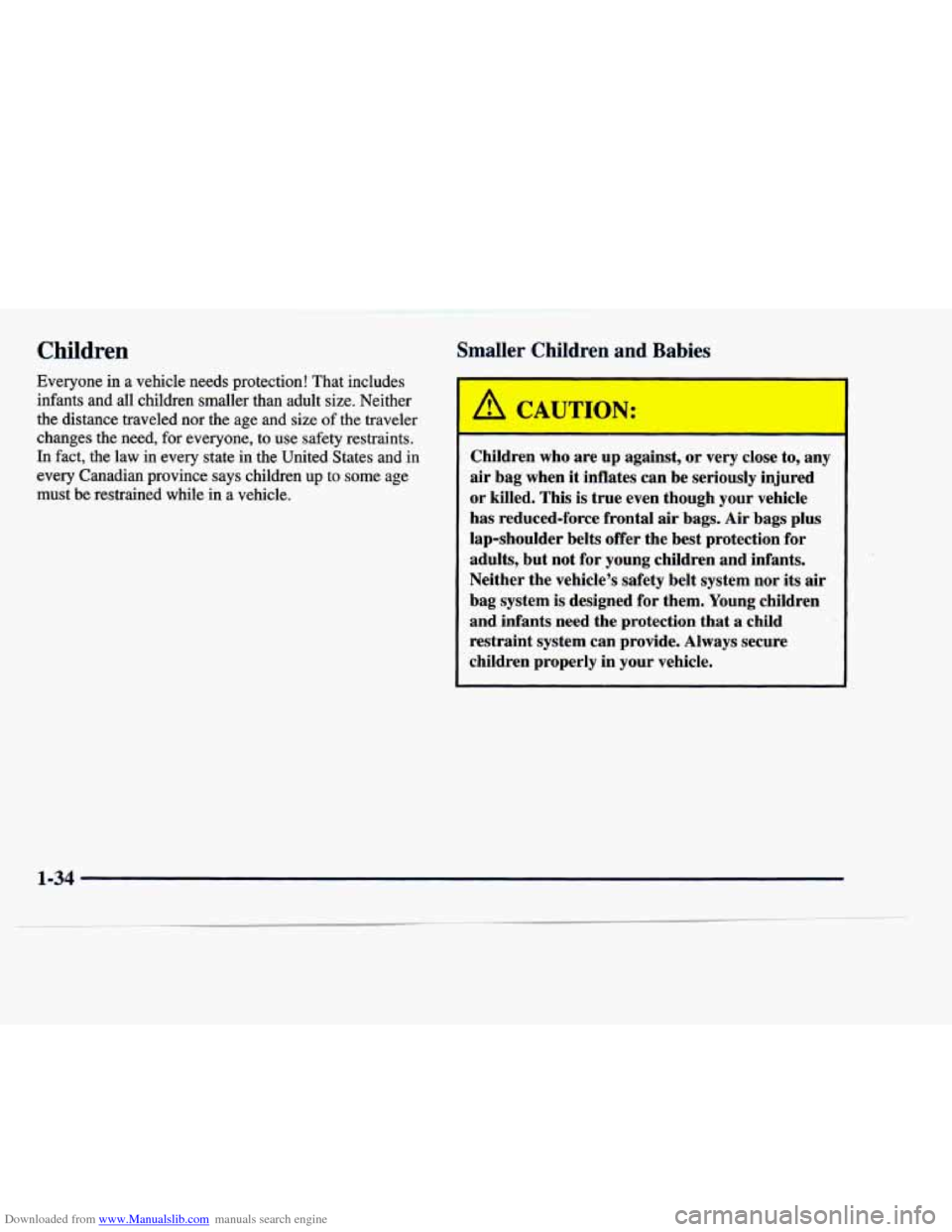
Downloaded from www.Manualslib.com manuals search engine Children Smaller Children and Babies
Everyone in a vehicle needs protection! That includes
infants and all children smaller than adult size. Neither
the distance traveled nor the age and size
of the traveler
changes the need, for everyone, to use safety restraints.
In fact, the law
in every state in the United States and in
every Canadian province says children up to some age
must be restrained while in a vehicle.
b CAUTION:
I
Children who are up against, or very close to, any
air bag when it inflates can be seriously injured
or killed. This is true even though your vehicle
has reduced-force frontal air bags. Air bags plus
lap-shoulder belts offer the best protection for
adults, but not for young children and infants.
Neither the vehicle’s safety belt system nor its
air
bag system is designed for them. Young children
and infants need the protection that a child
restraint system can provide. Always secure
children properly in your vehicle.
1-34
Page 50 of 386
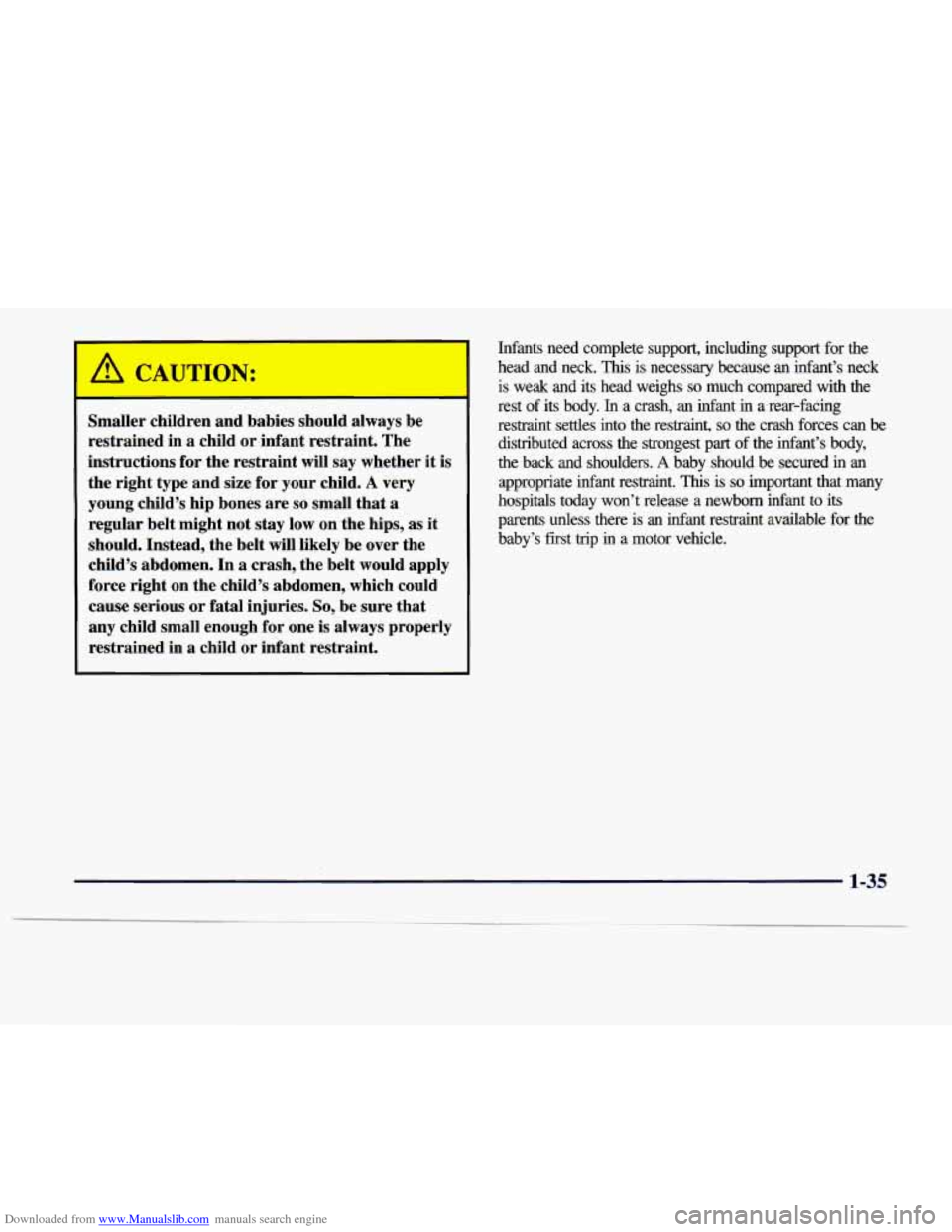
Downloaded from www.Manualslib.com manuals search engine I A AUTION:
Smaller children and babies should always be
restrained in
a child or infant restraint. The
instructions for the restraint will say whether it is
the right type and size
for your child. A very
young child’s hip bones are
so small that a
regular belt might not stay low on the hips, as it
should. Instead, the belt will likely be over the
child’s abdomen.
In a crash, the belt would apply
force right on the child’s abdomen, which could
cause serious or fatal injuries.
So, be sure that
any child small enough for one is always properly
restrained in a child or infant restraint.
Infants need complete support, including support for the
head and neck.
This is necessary because an infant’s neck
is weak and its head weighs so much compared with the
rest of its body.
In a crash, an infant in a rear-facing
restraint settles into the restraint,
so the crash forces can be
distributed across the strongest part of the infant’s body,
the back and shoulders.
A baby should be secured in an
appropriate infant restraint. This is so important that many
hospitals today won’t release a newborn infant to its
parents unless there is an infant restraint available for the
baby’s first
trip in a motor vehicle.
1-35